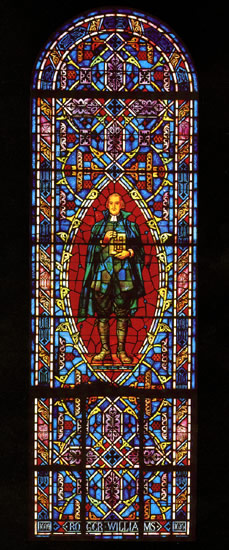
To avoid persecution in England, he immigrated to America, arriving in Boston on Feb. 5, 1631. He worshipped with a congregation in the city for a few weeks, but refused to join them because the people of the church would not make a public declaration of their repentance for having been in communication with the Church of England.
Williams left Boston and went to Salem where he became the assistant to a minister named Skelton. However, before the middle of the summer, he was forced out of Salem by persecution. His next ministry was in Plymouth where he acted as assistant to the pastor, Ralph Smith. After the death of Skelton in Salem, Williams accepted an invitation to return to that city as paster of the church.
In the autumn of 1634, he was banished from the colony by the general court. The reason given was that he had questioned the rights of the civil power. Williams then established his own colony, located on Narragansett Bay and called Providence. The name was based on Williams’ belief that God had been merciful in his providence to him and his followers. He hoped the new colony would be a shelter for those persecuted for conscience. In the colony, rule was by the majority of the people and, consequently, a practice began that came to be known as the “town meeting,” a public meeting open to all members of the community to decide civil affairs.
For some time the colony remained a pure democracy. Williams believed that a systematic organization should be undertaken and went to England in 1643 to procure a charter. In England, he was treated well by the parliament, and a charter was granted which incorporated the people of Narragansett Bay with “full power and authority to govern themselves.”
Williams’ life was marked by adherence to the principle of individual liberty of conscience in regard to worship.
The left side border symbols of the Williams window, numbered from top to bottom, are: 1. a Maltese cross, also called the “Regeneration Cross” because it symbolizes new birth, the name is taken from the island of Malta. The cross was the emblem of the famous Knights of St. John organized in the 11th century and permitted by Charles V to settle on Malta. Traditionally, a cross represents the sacrificial love of God as revealed in the death of Christ; 2. a bethel or set of doors with another small set of doors within representing individual access to God through Christ. Bethel means “the House of God”; and 3. the shield of St. Philip with a slender cross and two loaves of bread representing the feeding of the multitude when Philip indicated that there was a boy in the group with some loaves and fishes.
The right side border symbols of the Williams window, numbered from top to bottom, are: 1. the Alleluia symbol, with a candle and a circle of light, representing joy expressed for the reappearance of Christ, the “Light of the World,” at the time of the Resurrection; 2. a censer used for the burning of incense symbolizing adoration, prayer, and worship; and 3. the symbol of Agnus Dei, an image of a lamb superimposed upon a seven-sealed book, representing the suffering of the Savior in order to redeem and possess the world (Revelation 5:6-14; cf. Jeremiah 32:14).














